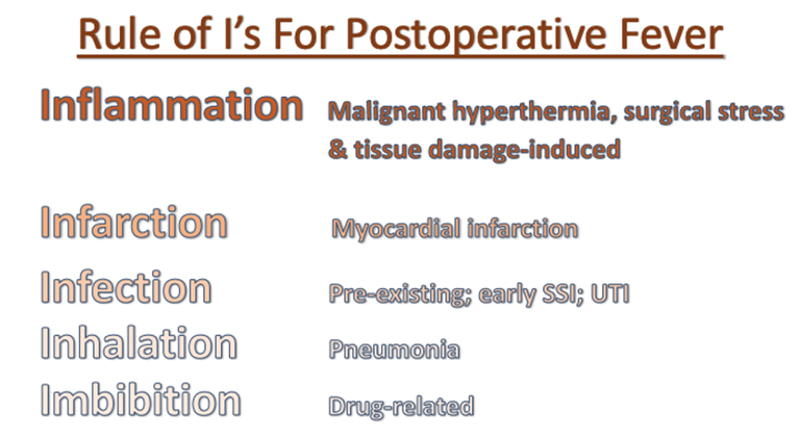
Practice Perfect 716
New Rules for Postoperative Complications
New Rules for Postoperative Complications

As we saw in last week’s Practice Perfect, atelectasis is not one of the causes of postoperative fever. In fact, the mnemonic of the Rule of W for postoperative fever (Wind, Water, Wound, Walk, Wonder), although classically memorized by almost all medical professionals, clearly needs some updating. The first update must be entirely removing atelectasis from the mnemonic.
Before we get to that, I can’t help but mention an interesting study about the Rule of W because if the first W (atelectasis) is incorrect, then what about the rest of the Rule? Can it be applied to other postoperative complications?
Hyder and colleagues examined the Rule of W to determine the frequency and timing of common complications1. They examined a cohort of general surgical and vascular surgery patients who underwent elective inpatient surgeries using the American College of Surgeons National Surgical Quality Improvement Program database between 2005 and 2011. They studied 614,525 patients and found 51,173 (9.88%) suffered complications within the first 30 days. Table 1 shows the complications, incidence, and most common postoperative day in which they occurred.
Table 1. Postoperative complications with incidence and most common timeframe of occurrence1.
| Complication | Incidence | Occurrence Time (POD) |
| Pneumonia | 5,847 | 1, 2, 3 (peak on day 2) |
| UTI | 9,459 | 3 |
| Superficial surgical site infection | 20,460 | 4 and 5-30 |
| Deep surgical site infection | 11,847 | 5-30 |
| Venous thromboembolism | 4,478 | Consistent elevated risk through 30 days |
| Myocardial infarction | 1,813 | POD 0 |
There are a few important points to consider from this study. First, the most common complication immediately after surgery was myocardial infarction, then in the first three days came pneumonia (peaking at day 2), and then either pneumonia or urinary tract infections at day 3. After that, surgical site infections were more common for the rest of the month after surgery with thromboembolism remaining a significant risk (though never a primary risk) throughout the postoperative month. Despite the fact that the study did not examine postoperative fever, all of the complications could present with an associated fever. It should also be noted that because the patients in this study underwent general and vascular procedures – not orthopedic types of procedures – the incidence of pneumonia and UTI may be skewed toward these complications. For example, it is common for patients to maintain urinary catheters for a greater time after abdominal surgery than for most orthopedic procedures.
From this data analysis, the authors proposed a new Rule of W for postoperative complications in the first 30 days1:
Wind (Pneumonia)
Water (UTI)
Wound (Superficial and deep surgical site infection)
Walking (Venous thromboembolism)
This new Rule of W is a much more accurate indicator of postoperative complications. One last observation from Hyder’s study to bring us back to our topic of fever: They found fever to be common in the postoperative time period but found no specific association of fever with these complications, and the authors questioned the original rationale for the Rule of W’s to predict fever causes at all1. With this study in mind, and based on last week’s Practice Perfect, I’m ceasing my use of the Rule of W for postoperative fever because it is both incomplete and inaccurate. Instead, here is my suggested “Rule of I’s” for postoperative fever.

This mnemonic includes the more common inflammatory causes, eliminates atelectasis, and includes other causes not emphasized in the prior mnemonic. For a little more detail, take a look at Table 2 below. It includes some further specifics about the diagnoses and the timing related to the postoperative period. Keep in mind that although fever may occur with all of the diagnoses, procedure-related inflammatory causes are most common very early, while infections become increasingly common causes over the longer term.
Table 2. Diagnoses and timing for the new Rule of I’s

As in all things medicine related, nothing replaces a thorough history, physical, and rational thought process when addressing patient complications. However, these new rules will hopefully assist with framing and maintaining a proper thought process when taking care of your patients.

-
Hyder JA, Wakeam E, Arora V, Hevelone ND, Lipsitz SR, Nguyen LL. Investigating the “Rule of W,” a mnemonic for teaching on postoperative complications. J Surg Educ. May-Jun 2015;72(3):430-437.
Follow this link































Comments
There are 0 comments for this article